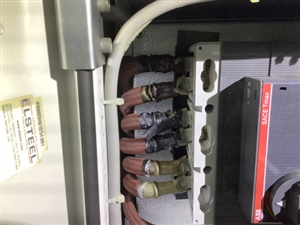
lyledunn:
....I also think the tail as are undersized by some margin.
Can't argue with that.
The tripping units should be able to operate at In indefinitely (at least withing reason - a couple of decades non stop might not be good) so I doubt if that is the problem, but it is probably a good move to get confirmation from ABB. You say that the switching device is only rated at 800A which I assume means that while the tripping unit is rated at 1000A, the device it is operating is only rated at 800A (e.g. T6 800). If this is the case then the device itself will be overheating as at 900A it will generate 25% more heat than it can dissipate at its rated temperature (so as a rough guide the temperature rise will increase by 25% which will put extra heat into the undersized tails).

OMS:
...the whole assembly should be subject to BS EN 61439 and had the appropriate temperature rise test undertaken
I am happy to be corrected but I thought that BS EN 61439 allowed for verification by calculation (I am not an expert - but I know someone who is, so I can always ask....) so it is not necessary to actually perform the temperature rise test, though I am always suspicious of calculations in the place of real performance tests. You are certainly right that it may well need an over-rated device to meet the temperature rise requirements. When 60439 was replaced by 61439 there was a widespread complaint that customers were being forced to buy larger switchboards.
The ABB Sace TMax has been around for a while so it potentially could be a board to BS EN 60439, but only if it is older than about 15 years.
Edit - just read the latest comment about it being a new board, so ignore the final sentence.
lyledunn:
The device is one of three CBs inside a new main panel which was constructed by local panel builders under instruction from a consultant.
So who is the designer? It sounds as if there is a grey area between the panel builders and the consultant as to who is actually the designer.
The tripping unit is an electronic (which nowadays means computer) one, as far as I am aware, and therefore there would be no thermal priming as there would have been in the old days (showing my age here) so it should not matter what the previous current has been as far as tripping goes.
mapj1:
.... I also wonder how sound the crimping is
That came into my mind also, but the other aspect is are the lugs the correct size? If they are undersized it just compounds the problem, whether or not the crimping is sound. I have come across overheating due to 50/70 sq mm lugs being put on 95 sq mm cable.
Alasdair Anderson:lyledunn:
The device is one of three CBs inside a new main panel which was constructed by local panel builders under instruction from a consultant.So who is the designer? It sounds as if there is a grey area between the panel builders and the consultant as to who is actually the designer.
The tripping unit is an electronic (which nowadays means computer) one, as far as I am aware, and therefore there would be no thermal priming as there would have been in the old days (showing my age here) so it should not matter what the previous current has been as far as tripping goes.
I am showing my age Alasdair! I don't know how many times I have been told that and still it doesn't stick!
Ah, the designer? Well I wouldn't be one for love nor money! I don't think the industry gives them the credit they deserve. The consultant is a lovely chap who seems to work on his own. It does appear that the correct details were not passed to the panel builders. Whoever is to blame, lets hope they have adequate PI insurance in place!
We're about to take you to the IET registration website. Don't worry though, you'll be sent straight back to the community after completing the registration.
Continue to the IET registration site